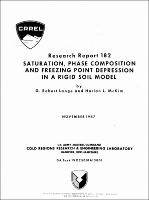Please use this identifier to cite or link to this item:
https://hdl.handle.net/11681/5810Full metadata record
| DC Field | Value | Language |
|---|---|---|
| dc.contributor.author | Lange, G. Robert | - |
| dc.contributor.author | McKim, H. L. (Harlan L.) | - |
| dc.date.accessioned | 2016-03-21T21:08:39Z | - |
| dc.date.available | 2016-03-21T21:08:39Z | - |
| dc.date.issued | 1967-11 | - |
| dc.identifier.uri | http://hdl.handle.net/11681/5810 | - |
| dc.description | Research Report | - |
| dc.description | Abstract: Calorimetry was used to explore the effects of saturation and temperature upon the phase composition of the water at below freezing temperatures in a porcelain block with fine pore spaces. The effect of pore size upon phase composition was held constant by the rigid model. The percent of original Water frozen was determined for a wide range of saturations and several temperature levels. Nucleation was avoided. After 20 hr of freezing, 64 of 74 determinations showed less than 10% or more than 70% of the water frozen. Thus, a metastable condition of saturation and temperature for guaranteed freezing was defined for the pore space model with time of freezing held constant. Freezing points were also measured at various levels of saturation in the same porcelain blocks. A range of effective pore sizes was calculated from these data, thus characterizing the pore size distribution. Both freezing point depression and guaranteed freezing data, when plotted against saturation, appear to conform to an empirical relationship of the form: θ = β log𝖾 𝖲 + ε in which θ may be either the freezing point depression ∆θ or the temperature for guaranteed freezing, θ𝖿, and 𝖲 is the saturation coefficient. The slope constant β has the same value (1.35) for both θ𝖿 and ∆θ. ε, the temperature intercept at maximum saturation (𝖲 = 0.92), has different values (-0.4°C and -3.3°C) for ∆θ and θ𝖿 respectively. It is concluded that the phase composition of the water in frozen soils is dependent upon the degree of saturation as well as the temperature. It is suggested that rigid models are useful tools for investigating the freezing process in soils. | - |
| dc.publisher | Cold Regions Research and Engineering Laboratory (U.S.) | - |
| dc.publisher | Engineer Research and Development Center (U.S.) | - |
| dc.relation | http://acwc.sdp.sirsi.net/client/en_US/search/asset/1013123 | - |
| dc.relation.ispartofseries | Research report (Cold Regions Research and Engineering Laboratory (U.S.)) ; 182. | - |
| dc.rights | Approved for public release; distribution is unlimited. | - |
| dc.source | This Digital Resource was created from scans of the Print Resource | - |
| dc.subject | Soils | - |
| dc.subject | Frozen soils | - |
| dc.subject | Frozen ground | - |
| dc.subject | Permafrost | - |
| dc.subject | Calorimetry | - |
| dc.subject | Soil water | - |
| dc.subject | Soil water composition | - |
| dc.subject | Soill saturation | - |
| dc.subject | Freezing | - |
| dc.subject | Frost | - |
| dc.subject | Soil models | - |
| dc.subject | Mathematical models | - |
| dc.subject | Mathematical analysis | - |
| dc.title | Saturation, phase composition and freezing point depression in a rigid soil model | - |
| dc.type | Report | en_US |
| Appears in Collections: | Research Report | |
Files in This Item:
| File | Description | Size | Format | |
|---|---|---|---|---|
| CRREL-Research-Report-182.pdf | 1.25 MB | Adobe PDF |  View/Open |